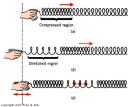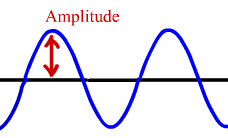
Types of Waves
- Water waves, sound waves and the waves that travel along a spring rope are mechanical waves.
Light waves, radio waves, and X rays are examples of electromagnetic waves.
There are three different divisions for mechanical waves
+ tranverse wave + longitude wave
+ surface waves
- Tranverse Wave causes the particles of the medium to vibrate perpendicularly to the direction of motion of the wave.
An example of this type of wave can be found in a piano and guitar strings.
- Longitudinal wave causes particles of a medium to move parallel to the direction of the wave.
An example of this is a sound wave.
- Surface waves are a mixture of trnverse and longitudinal waves.
An example of this are waves in a lake or ocean.

- What's a Wave Pulse?
It's a single disturbance that travels through a medium
- What's a Traveling Wave?
It's a source that's vibrating with simple harmonic motion that will produce a continuous traveling wave.
The Measures of a Wave:Frequency, Wavelength, and Velocity
- A period is the shortest time interval during which the motion repeats itself.
- What's the frequency of a wave?
The number of complete vibrations per second measured at a fixed location.
Frequency is measured in hertz. One hertz is one vibration per second.
Frequency and period of a wave are related by the equation f=wavelength/T
- What's the wavelength?
The shortest distance between points where the wave pattern repeats itself.
- Crests(C) are high points of each wave motion.
- Troughs(T) are low points of each wave motion.
Each crest is one wavelength from the next crest.
- How fast does a traveling wave move?
You could run close to the wave just fast enogh so the wave looks like it's standing still
or
you can take two photgraphs at a known time/ interaval apart. During the one second time/ interval the crest moved 8 meters to the right velocity of an object.
The velocity can be calculated from the equation V= wavelength/T can be more conveniently written as V= wavelength/f

Amplitude of a Wave
Two waves with the same frequency can hvae different wavelengths.
Waves can different from one another in more than one way.
For example a rope can be shaken violently or gently, a sound can be loud or soft
- The Amplitude of a wave is its maximum displacement from the rest or equilibrium position.
In order to produce a wave with larger amplitude, more labor has to be made.
For instance strong winds create larger water waves than gentle breezes.
The larger the amplitude the greater the energy transferred.

Superposition of Waves
In order to analyze the effects of waves the principle of superposition should be used.
- Principle of Superposition states that the displacement of a medium caused by two or more waves is the algebraic sum of the displacements caused by the individual waves.
- Interference is the result of the superposition of two or more waves.
Interference can either be constructive or destructive.
- Constructive Interference occurs when the wave displacenents are in the same direction.
The result is the wave with larger amplitude than any of the individual waves.
- Destruction Interference is the superposition of waves resulting in a combined wave with zero amplitude.
Standing Waves
- Node is a point where disturbances caused by two or more waves result in no displacement.
At a node, the medium is never displaced as the waves pass through each other.
A node is produced by the destuctive interference of waves.
- Antinode is the point of maximum displacement of two super imposed waves.
At an antinode the displacement caused by interfering waves is largest
- Constructive interference of waves produces antinodes.
- A standing wave is a wave that appears to be standing still.
A standing wave has stationary nodes and antinodes. It's the result of identical waves traveling in opposite directions.

Reflection of Waves
Waves on the surface of water move in two dimensions; while sound and electromagnetic waves moves in three dimensions.
The direction of waves moving in two or three dimensions is often shown by ray diagrams.
A ray is a line drawn at a right angle to the crest of the wave.
- What's a normal?
The direction of the barrier is also known by a line drawn at a right angle to it.
- What's an angle of Incidence?
The angle between the incident ray and the normal.
- The definition of an angle of reflection is the angle between the normal and the reflected ray.
- The law of reflection states that the angle of incidence is equal to the angle of reflection.
Refraction of Waves and Diffraction and Interference of Waves
As the waves move from deep to shallow water, their wavelength decreases and the direction of the waves changes.
This occurs because the waves in the shalow water are generated by the waves in deep water, their frequency isn't changed.
From the equation v= wavelength/f, the decrease in the wavelength of the waves means that the velocity is lower in the shallower water.
- The change of wave direction at the boundary between two media is what?
Refraction
- The spreading of waves around the edge of a barrier is what?
Diffraction
5 Website links
Velocity and Intensity·
Waves·
The nature of Waves·
Energy Tranfer·
Longitudinal Waves·
Wave Motion
5 Magazine links
- Main Source= PhysicsText(Merrill Physics: Principles and Problems) By Paul W. Zitzewitz and Robert F. Neft(1992)
- Science In Press (October 30,1998) Isopptic Mass and Lattice constant: X-ray standing wave measurement.By Alexander Kazimirou, Jorge Zegenhayen and Manuel Cardona
- The New York Times (December 5,1958)(1857-current file) Metals Welded by soumd waves.By Christian Johnson
- The New York Times (May1,1936)(1857-current file) Radio waves Transmitted by Pipe,Like voice Through Speaking- Tube. By William L. Laurences
- The New York Times (July 27,1941)(1857-current files) Short- Wave Pick Ups. By W.T. Arms









